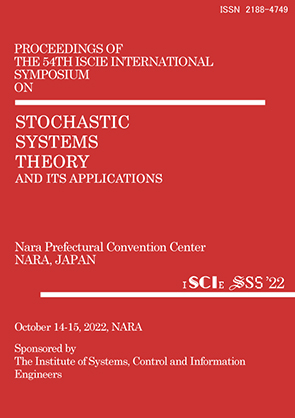Current issue
Displaying 1-14 of 14 articles from this issue
- |<
- <
- 1
- >
- >|
The 54th ISCIE International Symposium on Stochastic Systems Theory and Its Applications (Oct. 2022, NARA)
-
2023 Volume 2023 Pages 1-7
Published: March 24, 2023
Released on J-STAGE: September 25, 2023
Download PDF (528K) -
2023 Volume 2023 Pages 8-12
Published: March 24, 2023
Released on J-STAGE: September 25, 2023
Download PDF (3677K) -
2023 Volume 2023 Pages 13-18
Published: March 24, 2023
Released on J-STAGE: September 25, 2023
Download PDF (375K) -
2023 Volume 2023 Pages 19-27
Published: March 24, 2023
Released on J-STAGE: September 25, 2023
Download PDF (2813K) -
2023 Volume 2023 Pages 28-34
Published: March 24, 2023
Released on J-STAGE: September 25, 2023
Download PDF (122K) -
2023 Volume 2023 Pages 35-40
Published: March 24, 2023
Released on J-STAGE: September 25, 2023
Download PDF (164K) -
2023 Volume 2023 Pages 41-45
Published: March 24, 2023
Released on J-STAGE: September 25, 2023
Download PDF (285K) -
2023 Volume 2023 Pages 46-55
Published: March 24, 2023
Released on J-STAGE: September 25, 2023
Download PDF (198K) -
2023 Volume 2023 Pages 56-61
Published: March 24, 2023
Released on J-STAGE: September 25, 2023
Download PDF (585K) -
2023 Volume 2023 Pages 62-68
Published: March 24, 2023
Released on J-STAGE: September 25, 2023
Download PDF (164K) -
2023 Volume 2023 Pages 69-74
Published: March 24, 2023
Released on J-STAGE: September 25, 2023
Download PDF (285K) -
2023 Volume 2023 Pages 75-80
Published: March 24, 2023
Released on J-STAGE: September 25, 2023
Download PDF (141K) -
2023 Volume 2023 Pages 81-86
Published: March 24, 2023
Released on J-STAGE: September 25, 2023
Download PDF (645K) -
2023 Volume 2023 Pages 87-92
Published: March 24, 2023
Released on J-STAGE: September 25, 2023
Download PDF (186K)
- |<
- <
- 1
- >
- >|
